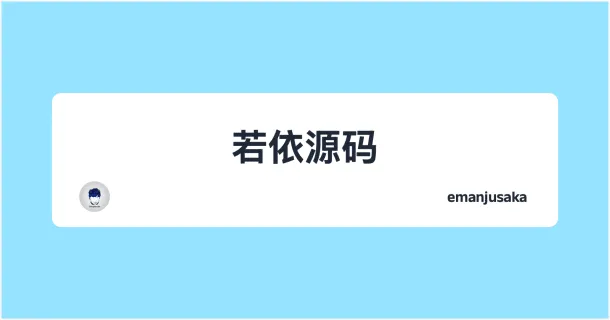若依源码:接口限流功能的实现

公众号:emanjusaka的编程栈
by emanjusaka from https://www.emanjusaka.com/archives/ruoyi-ratelimiter 彼岸花开可奈何
本文是若依的源码解读,这是一个系列文章,欢迎关注我的博客或者微信公众号获取后续文章更新。
若依项目中接口限流是通过注解 +AOP+lua 脚本去实现的,下面我们来分析一下具体的代码实现。
定义注解
RateLimiter.java
/**
* 限流注解
*
* @author ruoyi
*/
@Target(ElementType.METHOD)
@Retention(RetentionPolicy.RUNTIME)
@Documented
public @interface RateLimiter
{
/**
* 限流key
*/
public String key() default CacheConstants.RATE_LIMIT_KEY;
/**
* 限流时间,单位秒
*/
public int time() default 60;
/**
* 限流次数
*/
public int count() default 100;
/**
* 限流类型
*/
public LimitType limitType() default LimitType.DEFAULT;
}
首先定义一个注解 @RateLimiter,其中包含四个参数分别是限流 key、限流时间、限流次数、限流类型。
全部都给了默认值,限流 key 默认值为 rate_limit:,这里设置的 key 只是限流 key 的前缀部分,具体使用还会追加类名和方法名。如果限流类型是 IP 还要再加上 IP。
限流时间默认值是 60s。
限流次数默认值是 100 次。
限流时间内访问接口的次数不能超过限流次数。
限流类型默认是全局限流,也就是只要是调用接口就会限制。
通过 AOP 拦截请求实现限流
RateLimiterAspect.java
/**
* 限流处理
*
* @author ruoyi
*/
@Aspect
@Component
public class RateLimiterAspect
{
private static final Logger log = LoggerFactory.getLogger(RateLimiterAspect.class);
private RedisTemplate<Object, Object> redisTemplate;
private RedisScript<Long> limitScript;
// 注入 redisTemplate
@Autowired
public void setRedisTemplate1(RedisTemplate<Object, Object> redisTemplate)
{
this.redisTemplate = redisTemplate;
}
// 注入 limitScript
@Autowired
public void setLimitScript(RedisScript<Long> limitScript)
{
this.limitScript = limitScript;
}
// 在有注解@RateLimiter的方法前执行
@Before("@annotation(rateLimiter)")
public void doBefore(JoinPoint point, RateLimiter rateLimiter) throws Throwable
{
int time = rateLimiter.time();
int count = rateLimiter.count();
// 获取组合的键
String combineKey = getCombineKey(rateLimiter, point);
List<Object> keys = Collections.singletonList(combineKey);
try
{
// 执行Redis脚本,获取限流结果
Long number = redisTemplate.execute(limitScript, keys, count, time);
// 如果结果为空或者超过限制次数
if (StringUtils.isNull(number) || number.intValue() > count)
{
throw new ServiceException("访问过于频繁,请稍候再试");
}
log.info("限制请求'{}',当前请求'{}',缓存key'{}'", count, number.intValue(), combineKey);
}
catch (ServiceException e)
{
throw e;
}
catch (Exception e)
{
throw new RuntimeException("服务器限流异常,请稍候再试");
}
}
public String getCombineKey(RateLimiter rateLimiter, JoinPoint point)
{
// 创建一个StringBuilder对象,并初始化为RateLimiter的key
StringBuffer stringBuffer = new StringBuffer(rateLimiter.key());
// 如果RateLimiter的限制类型是IP
if (rateLimiter.limitType() == LimitType.IP)
{
// 获取当前请求的IP地址,并追加到StringBuilder对象后,再追加一个"-"
stringBuffer.append(IpUtils.getIpAddr()).append("-");
}
// 获取JoinPoint的MethodSignature对象
MethodSignature signature = (MethodSignature) point.getSignature();
// 获取MethodSignature对象的方法对象
Method method = signature.getMethod();
// 获取方法的声明类
Class<?> targetClass = method.getDeclaringClass();
// 将方法的声明类和方法的名称追加到StringBuilder对象后,并在它们之间追加一个"-"
stringBuffer.append(targetClass.getName()).append("-").append(method.getName());
// 返回StringBuilder对象的字符串表示
return stringBuffer.toString();
}
}
既然是实现接口限流功能肯定是要在切点前面行(也就是在接口执行之前),所以使用前置通知@Before。
通过执行 lua 脚本获取接口在限流时间内的执行次数,如果超过了限流次数就抛出异常限制接口的调用。
通过 lua 脚本可以保证操作的原子性。
限流类型是 IP 的话获取组合键的时候需要获取请求来自的 IP。这里若依采取的是自己实现的方法,在这里对其不再展开,如果感兴趣它的实现可以看我的另一篇文章若依源码:获取 IP 方法的工具类。
注入 lua 限流脚本
RedisConfig.java
/**
* redis配置
*
* @author ruoyi
*/
@Configuration
@EnableCaching
public class RedisConfig {
@Bean
@SuppressWarnings(value = {"unchecked", "rawtypes"})
public RedisTemplate<Object, Object> redisTemplate(RedisConnectionFactory connectionFactory) {
RedisTemplate<Object, Object> template = new RedisTemplate<>();
template.setConnectionFactory(connectionFactory);
FastJson2JsonRedisSerializer serializer = new FastJson2JsonRedisSerializer(Object.class);
// 使用StringRedisSerializer来序列化和反序列化redis的key值
template.setKeySerializer(new StringRedisSerializer());
template.setValueSerializer(serializer);
// Hash的key也采用StringRedisSerializer的序列化方式
template.setHashKeySerializer(new StringRedisSerializer());
template.setHashValueSerializer(serializer);
template.afterPropertiesSet();
return template;
}
@Bean
public DefaultRedisScript<Long> limitScript() {
DefaultRedisScript<Long> redisScript = new DefaultRedisScript<>();
redisScript.setScriptText(limitScriptText());
redisScript.setResultType(Long.class);
return redisScript;
}
/**
* 限流脚本
*/
private String limitScriptText() {
return "local key = KEYS[1]\n" +
"local count = tonumber(ARGV[1])\n" +
"local time = tonumber(ARGV[2])\n" +
"local current = redis.call('get', key);\n" +
"if current and tonumber(current) > count then\n" +
" return tonumber(current);\n" +
"end\n" +
"current = redis.call('incr', key)\n" +
"if tonumber(current) == 1 then\n" +
" redis.call('expire', key, time)\n" +
"end\n" +
"return tonumber(current);";
}
}
这个 Redis 的配置类做了两件事,一个是设置 RedisTemplate 的序列化规则,一个就是注入了 lua 脚本。
设置 RedisTemplate 的序列化规则代码比较固定没啥可说的。我们主要讲解一下 lua 脚本。
local key = KEYS[1]
定义键名为脚本的第一个参数
local count = tonumber(ARGV[1])
将脚本的第二个参数转换为数字,作为限制的数量
local current = redis.call('get', key);
将脚本的第三个参数转换为数字,作为过期时间
if current and tonumber(current) > count then
return tonumber(current);
end
如果当前值存在且大于限制数量就返回当前值
current = redis.call('incr', key)
对键的值进行递增操作
if tonumber(current) == 1 then
redis.call('expire', key, time)
end
如果递增后的值为1,表示这是第一次设置键
设置键的过期时间
使用方法
@RestController
public class TestController {
@RateLimiter(count = 10, time = 10, limitType = LimitType.IP)
@GetMapping("/test")
public void test() {
System.out.println("test");
}
}
通过注解的方式使用,也可以不设置参数都采用默认值。怎样调整参数看具体需求。



